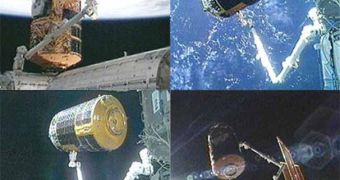In a new International Space Station (ISS) first, the H2 Transfer Vehicle (HTV) unmanned cargo freighter, belonging to the Japanese space agency JAXA, has been undocked from the station, and released over the Pacific Ocean. This spacecraft was the first of its kind, and was successful on its first launch as well. JAXA is very pleased with its accomplishment, which places it in the exclusive club of space agencies that have unmanned cargo ships capable of reaching the ISS. The other agencies include the Russian one (RosCosmos), and the European Space Agency (ESA), Space reports.
The undocking procedures for the new capsule were delayed by about 90 minutes (another Earth orbit) from the originally planned time. The decision was prompted by the fact that a large piece of space junk – pertaining to an old Soviet satellite – passed very close to the station, and may have impacted the HTV in the process. The cargo container was released at around 1:30 pm EDT (1730 GMT), and started firing up its engines a few moments later, heading for a terminal atmospheric reentry.
While the spacecraft has a number of thrusters that help with propulsion and maneuvers, it doesn't have the ability to, for example, guide itself to a docking bay on the station. After it is launched, and reaches the ISS in orbit, it is captured with the station's robotic arm, which then guides it to the correct docking station. The same process takes place again when it’s time to undock. The robotic arm pushes the HTV as far away from the station as possible, releases it, and the spacecraft fires up its own engines.
The unique thing about the 33-foot (10-meter) long, 14-foot (4.4-meter) wide space cylinder is that it can carry equipment for both internal and external use on the station. It can deliver supplies like food, water, propellants and scientific equipment, and also new experiments to be attached to the exterior of the ISS. At this point, it is the only spacecraft that can do this. In its standard configuration, the HTV is capable of carrying as much as 6 tons of cargo to orbit, although only 4 and a half were ferried up during its maiden voyage.
“We'd like to thank everybody across the planet for this beautiful vehicle. It was pretty much flawless from beginning to end,” told Mission Control NASA astronaut Nicole Stott, who was in charge of capturing the HTV when it first arrived. As it undocked, the spacecraft carried some 1,600 pounds (728 kilograms) of ISS debris safely secured inside.

 14 DAY TRIAL //
14 DAY TRIAL //